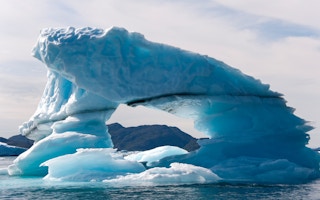Climate scientists have thought a little more deeply about the state of the Greenland ice sheet and their conclusions are ominous.
They think that the northern hemisphere’s largest assembly of ice and compacted snow is more vulnerable to climate change than anybody had previously thought.
Marion Bougamont of the Scott Polar Research Institute in Cambridge, UK, and colleagues report in Nature Communications that they factored in not just a mathematical model of the melting ice from Greenland, but also the role of the soft, yielding and absorbent mud and rock beneath.
The Greenland ice sheet is the planet’s second largest body of terrestrial ice. It covers 1.7 million square kilometres and if it were all to melt, the world’s sea levels would rise by more than seven metres.
“
Right now, about 200 gigatonnes of Greenland ice a year turn to water and run into the sea. This alone raises sea levels at the rate of 0.6 millimetres a year
Right now, about 200 gigatonnes of Greenland ice a year turn to water and run into the sea. This alone raises sea levels at the rate of 0.6 millimetres a year. In fact the increase in sea levels from all causes – glacier retreat worldwide, ice cap melting and ocean thermal expansion - is now 3 mm a year.
Researchers have repeatedly found evidence of an acceleration of melting, in some cases by looking at what is happening within the ice or on the surface, or by taking a new look at satellite data.
Less stable
But the latest calculation goes even deeper: into the mud below the ice. According to the new model, and to evidence from surveys, melting will be complicated by the conditions deep under the ice.
The ice sheets are moving, naturally and at different speeds, causing the ice to shear or flow, and the assumption has always been that the ice is flowing over hard and impermeable rock. A closer look suggests a different process.
Lakes of summer meltwater tend to form on the ice sheet surface: if the ice below fractures, these lakes can drain in a matter of hours. The meltwater flows down within the ice, and into the sediment below it.
“The soft sediment gets weaker as it tries to soak up more water, making it less resistant, so that the ice above moves faster. The Greenland ice sheet is not nearly as stable as we think,” said Poul Christofferson, a co-author.
And Dr Bougamont said: “There are two sources of net ice loss: melting on the surface and increased flow of the ice itself, and there is a connection between these mechanisms that isn’t taken into account by standard ice sheet models.”
Rapid change
At present, the annual flow of ice meltwater is more or less stable. In warmer years, the ice sheet becomes more vulnerable because more meltwater gets to the muddy absorbent bedrock. Because there is a limit to how much the sediment below can hold, the ice sheet becomes more vulnerable during extreme events such as heat waves.
And, of course, if under such a scenario it is vulnerable, it continues to become more vulnerable as average temperatures rise and extreme events become more frequent, and more extreme. And a closer look at recent geological history shows just how fast change can happen.
In a separate study in Nature Communications, Katharine Grant of the Australian National University and colleagues report that they examined evidence of the melting process at the close of each of the last five ice ages.
They looked at data from wind-blown dust in sediment cores from the Red Sea, and matched these with records from Chinese stalagmites to confirm a picture of pronounced climate change at the end of each ice age, and calculated that sea levels rose at the rate of 5.5 metres per century.
These however were exceptional events, and there were more than 100 smaller sea level events in between the big five.
“Time periods with less than twice the modern global ice volume show almost no indications of sea level rise faster than about 2 metres per century,” said Dr Grant. “Those with close to the modern amount of ice on Earth show rates of up to one to 1.5 metres per century.”










